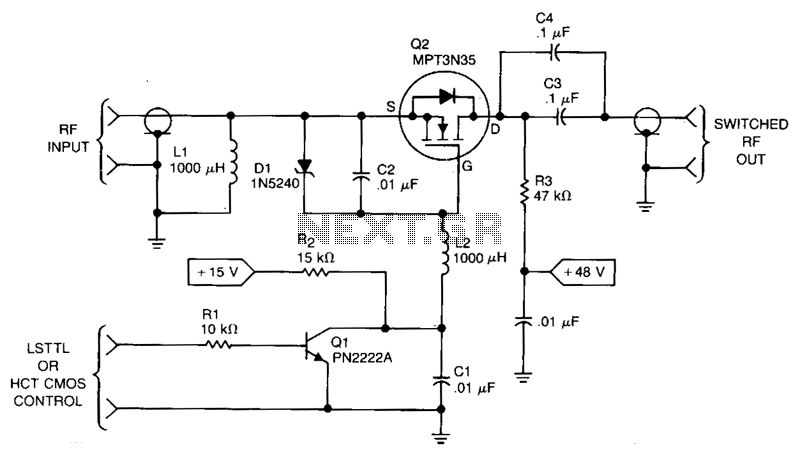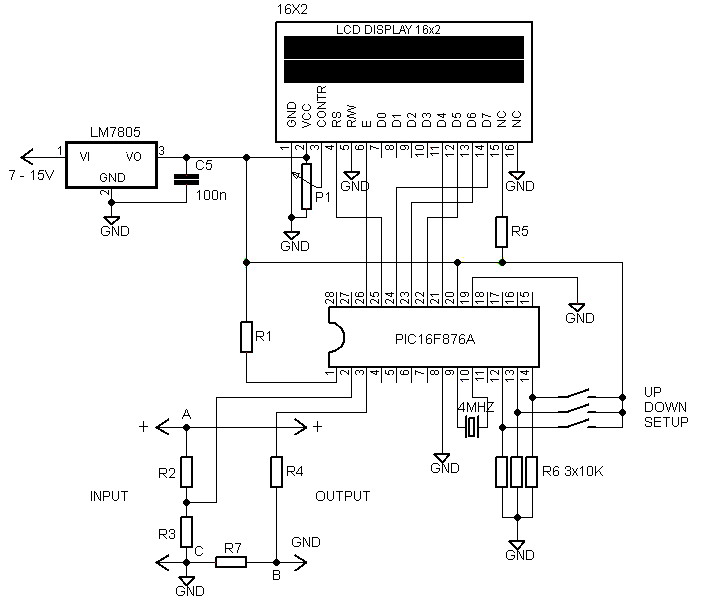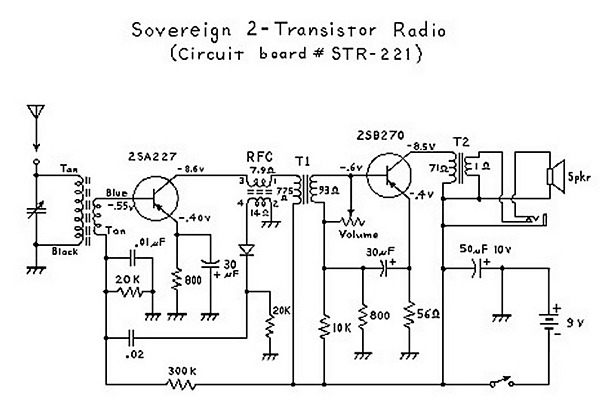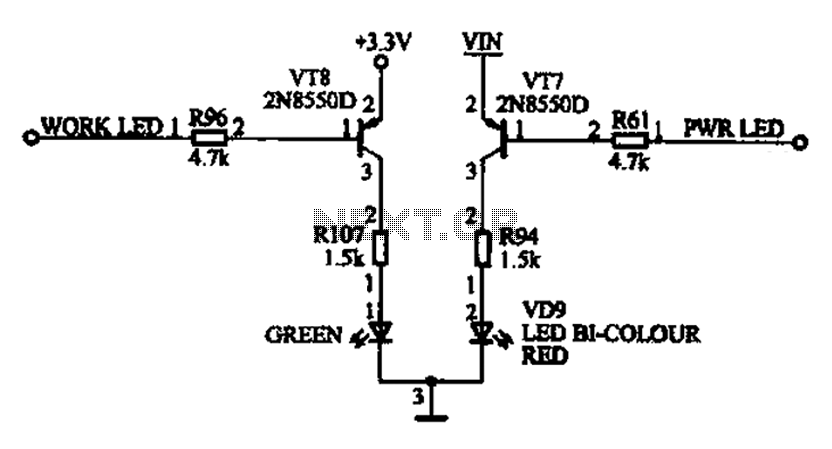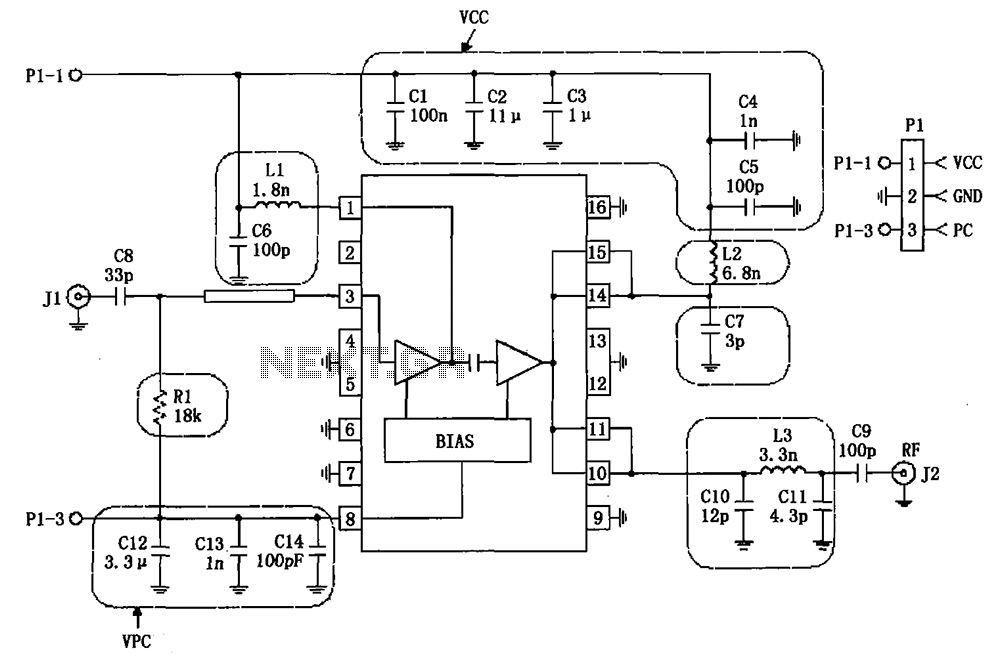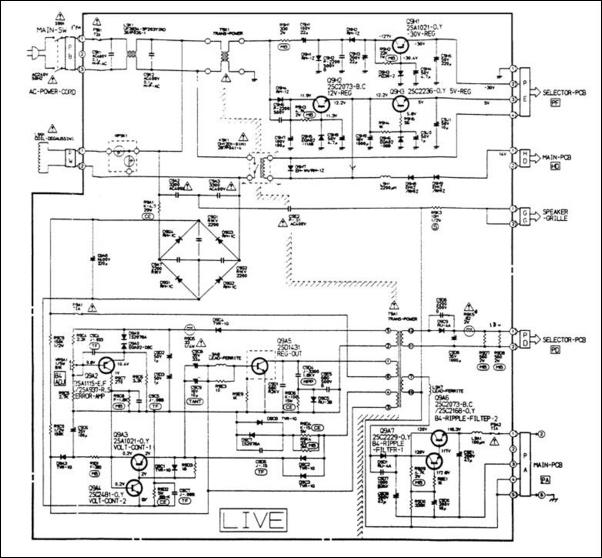
Schematic MP3 Car Audio Power AmplifierCircuits
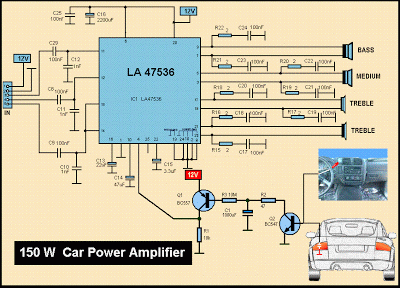
This is a diagram of a car audio active loudspeaker utilizing the LF353 operational amplifier from National Semiconductor. For optimal performance, the NE5532 is recommended to split the audio signal into three frequency bands using an active filter. The SANYO LA47536 is employed to amplify these signals. In stereo mode, this configuration will drive eight high-fidelity speakers, generating significant sound pressure. The LF353 and NE5532 are low-cost, high-speed, dual JFET input operational amplifiers featuring an internally trimmed input offset voltage (BI-FET II technology). They require low supply current while maintaining a large gain bandwidth product and fast slew rate. The well-matched high-voltage JFET input devices ensure very low input bias and offset currents. The LF353 is pin-compatible with the standard LM1558, allowing for an easy upgrade of existing LM1558 and LM358 designs. These amplifiers can be utilized in applications such as high-speed integrators, fast D/A converters, sample-and-hold circuits, and other circuits that demand low input offset voltage, low input bias current, high input impedance, high slew rate, and wide bandwidth. They also exhibit low noise and minimal offset voltage drift. The NE5532, a dual high-performance low-noise operational amplifier, outperforms standard operational amplifiers like the LM1458, LM1558, or LM4558 in terms of noise performance, output drive capability, and bandwidth. This makes it ideal for high-quality audio equipment, instrumentation, control circuits, and telephone channel amplifiers. The NE5532 is internally compensated for gains equal to one, and the NE5532A version is recommended for applications where low noise is critical, as it has guaranteed noise voltage specifications. Key features include an internally trimmed offset voltage of 10 mV, low input bias current of 50 pA, low input noise voltage of 25 nV, low input noise current of 0.01 pA, a wide gain bandwidth of 4 MHz, a high slew rate of 13 V/µs, low supply current of 3.6 mA, and high input impedance of 10^12 ohms. The LA47536 power amplifier includes a standby function at pin 4, which requires a voltage greater than 2V to activate the amplifier. Transistors Q1 and Q2 function as a remote stop switch. Activating the left indicator or pressing the brake lights drives Q2, which in turn drives Q1, applying a voltage greater than 2V at pin 4. The LA47536 features a pure complementary structure using V-PNP transistors on the high side and NPN transistors on the low side, ensuring high power and excellent audio quality. It encompasses all necessary functions for car audio applications, including a standby switch, muting function, and protection circuits, along with a self-diagnosis function for output offset detection. The threshold voltage at pin 4 is set to 2 VBE; when Vst is 2.0V or higher, the amplifier is on, and when Vst is 0.7V or lower, the amplifier is off. Pin 4 requires an operating current of at least 40µA. The IC enters a muted state when pin 22 is grounded, silencing the audio output. The muting function's time constant is determined by an external RC circuit, influencing the pop noise during power transitions. The LA47536 internally detects abnormal output offsets, outputting a signal from pin 25 to prevent speaker damage. This signal can be monitored by a microcontroller to manage the standby state or power supply. Abnormal output offsets may arise from input capacitor leakage. The pin 25 signal can be deactivated by grounding pin 1. To mitigate parasitic oscillations potentially induced by PCB layout, it is recommended to add a capacitor and resistor (0.1µF and 2.2Ω) in series between each output pin and ground. The frequency response at low frequencies can be enhanced by varying the capacitance of the input capacitors, with a recommended value of 2.2µF or smaller. Care should be taken not to ground the outputs with the STBY voltage around 1.4V, nor should the IC be turned off while grounded with the STBY voltage time constant. While the LA47536 includes a pop noise prevention circuit, further reduction can be achieved by employing the muting function. It is advisable to activate the muting function when power is applied and deactivate it after the output DC potential stabilizes. Conversely, when powering down, the muting function should be enabled before turning off the power supply. These strategies effectively minimize pop noise during operation.Here, it is a diagram of an Car audio active loudspeaker. The LF353 of, National Semiconductor. For Best Results using NE5532, is going to split audio signal into three bands (Active Filter). SANYO`S LA47536 is going to amplify these signals. In stereo mode, we shall have the action of eight high speakers who are going to create a very important sound pressure. These devices are low cost, high speed, dual JFET input operational amplifiers with an internally trimmed input offset voltage (BI-FET II technology). They require low supply current yet maintain a large gain band width product and fast slew rate. In addition, well matched high voltage JFET input devices provide very low input bias and offset currents.
The LF353 is pin compatible with the standard LM1558 allowing designers to immediately upgrade e the overall performance of existing LM1558 and LM358 designs. These amplifiers may be used in applications such as high speed integrators, fast D/A converters, sample and hold circuits and many other circuits requiring low input offset voltage, low input bias current, high input impedance, high slew rate and wide bandwidth.
The devices also exhibit low noise and offset voltage drift. (National Semiconductor) I recommended using IC NE5532. The NE5532 is a dual high-performance low noise operational amplifier. Compared to most of the standard operational amplifiers, such as the LM1458, LM1558, or LM4558 it shows better noise performance, improved output drive capability and considerably higher small-signal and power bandwidths. This makes the device especially suitable for application in high quality and professional audio equipment, instrumentation and control circuits, and telephone channel amplifiers.
The op amp is internally compensated for gains equal to one. If very low noise is of prime importance, it is recommended that the NE5532A version be used which has guaranteed noise voltage specifications. Features : Internally trimmed offset voltage: 10 mV Low input bias current: 50pA Low input noise voltage: 25 nV Low input noise current: 0.
01 pA Wide gain bandwidth: 4 MHz High slew rate: 13 V/us Low supply current: 3. 6 m High input impedance: 1012. Low total harmonic distortion : When the Power amplifier is installed behind in the suitcase, we shall need a switch works stop. The LA47536 possesses a function stand by in it pin4. This pine require a small tension superior to 2V in start up the amplifier. Transistor Q1 and Q2 makes the function of walking stop for distance. When the driver activates the left indicator, either light the back fires or press on the brake, lamps rear ignite driving Q2 who he even made to drive Q1 who applies a tension > 2V on it pin4.
Overview - A pure complimentary structure that uses V-PNP transistors on the high side and NPN transistors on the low side to provide high power and superb audio quality. - The LA47536 includes almost all the functions required for car audio use, including a standby switch, a muting function, and each protection circuit.
It also provides a self-diagnosis function (output offset detection). (Sanyo) The pin 4 threshold voltage is set to be 2 VBE. When Vst is 2. 0V or higher, the amplifier will be on, and when Vst, is 0. 7V or lower, the amplifier will be off. Note that pin 4 requires an operating current of at least 40uA. The IC is set to the muted state by setting pin 22 to the ground potential. In this state, the audio output is muted. The time constant with which the muting function operates is set by an external RC circuit, and this time constant influences the pop noise that occurs when the amplifier is turned on or off. During steady state operation, the LA47536 detects, internally, whether or not an abnormal amplifier output offset has occurred, and outputs this signal from pin 25.
Applications can prevent speaker burnout and other problems by having the system microcontroller detect this pin 25 output signal and control either the standby state or the power supply. (An abnormal output offset may be caused by, for example, input capacitor leakage current. ) The pin 25 signal is turned off by setting pin 1 to the ground potential. In some cases, parasitic oscillations may be induced by the PCB layout. This oscillation can be eliminated by adding the components listed below. Note that the optimal capacitor value must be verified by testing in the actual mounted state in the end product.
Connect a capacitor and resistor (0. 1uF and 2. 2) in series between each output pin and ground. The frequency characteristics in the low frequencies can be improved by making the capacitance of the input capacitors variable. The recommended capacitance is 2. 2uF and smaller. Do not ground the outputs with the STBY voltage at around 1. 4V. Also, do not turn the IC off in the grounded state with a time constant provided for the STBY voltage.
Although the LA47536 includes an pop noise prevention circuit, pop noise can be reduced even further by using the muting function as well. Activate the muting function at the same time as power is applied. Then, after the output DC potential has stabilized, turn off the muting function. When turning the amplifier off, first turn on the muting function and then turn off the power supply.
These two methods are effective at minimizing pop noise. 🔗 External reference
The LF353 is pin compatible with the standard LM1558 allowing designers to immediately upgrade e the overall performance of existing LM1558 and LM358 designs. These amplifiers may be used in applications such as high speed integrators, fast D/A converters, sample and hold circuits and many other circuits requiring low input offset voltage, low input bias current, high input impedance, high slew rate and wide bandwidth.
The devices also exhibit low noise and offset voltage drift. (National Semiconductor) I recommended using IC NE5532. The NE5532 is a dual high-performance low noise operational amplifier. Compared to most of the standard operational amplifiers, such as the LM1458, LM1558, or LM4558 it shows better noise performance, improved output drive capability and considerably higher small-signal and power bandwidths. This makes the device especially suitable for application in high quality and professional audio equipment, instrumentation and control circuits, and telephone channel amplifiers.
The op amp is internally compensated for gains equal to one. If very low noise is of prime importance, it is recommended that the NE5532A version be used which has guaranteed noise voltage specifications. Features : Internally trimmed offset voltage: 10 mV Low input bias current: 50pA Low input noise voltage: 25 nV Low input noise current: 0.
01 pA Wide gain bandwidth: 4 MHz High slew rate: 13 V/us Low supply current: 3. 6 m High input impedance: 1012. Low total harmonic distortion : When the Power amplifier is installed behind in the suitcase, we shall need a switch works stop. The LA47536 possesses a function stand by in it pin4. This pine require a small tension superior to 2V in start up the amplifier. Transistor Q1 and Q2 makes the function of walking stop for distance. When the driver activates the left indicator, either light the back fires or press on the brake, lamps rear ignite driving Q2 who he even made to drive Q1 who applies a tension > 2V on it pin4.
Overview - A pure complimentary structure that uses V-PNP transistors on the high side and NPN transistors on the low side to provide high power and superb audio quality. - The LA47536 includes almost all the functions required for car audio use, including a standby switch, a muting function, and each protection circuit.
It also provides a self-diagnosis function (output offset detection). (Sanyo) The pin 4 threshold voltage is set to be 2 VBE. When Vst is 2. 0V or higher, the amplifier will be on, and when Vst, is 0. 7V or lower, the amplifier will be off. Note that pin 4 requires an operating current of at least 40uA. The IC is set to the muted state by setting pin 22 to the ground potential. In this state, the audio output is muted. The time constant with which the muting function operates is set by an external RC circuit, and this time constant influences the pop noise that occurs when the amplifier is turned on or off. During steady state operation, the LA47536 detects, internally, whether or not an abnormal amplifier output offset has occurred, and outputs this signal from pin 25.
Applications can prevent speaker burnout and other problems by having the system microcontroller detect this pin 25 output signal and control either the standby state or the power supply. (An abnormal output offset may be caused by, for example, input capacitor leakage current. ) The pin 25 signal is turned off by setting pin 1 to the ground potential. In some cases, parasitic oscillations may be induced by the PCB layout. This oscillation can be eliminated by adding the components listed below. Note that the optimal capacitor value must be verified by testing in the actual mounted state in the end product.
Connect a capacitor and resistor (0. 1uF and 2. 2) in series between each output pin and ground. The frequency characteristics in the low frequencies can be improved by making the capacitance of the input capacitors variable. The recommended capacitance is 2. 2uF and smaller. Do not ground the outputs with the STBY voltage at around 1. 4V. Also, do not turn the IC off in the grounded state with a time constant provided for the STBY voltage.
Although the LA47536 includes an pop noise prevention circuit, pop noise can be reduced even further by using the muting function as well. Activate the muting function at the same time as power is applied. Then, after the output DC potential has stabilized, turn off the muting function. When turning the amplifier off, first turn on the muting function and then turn off the power supply.
These two methods are effective at minimizing pop noise. 🔗 External reference
